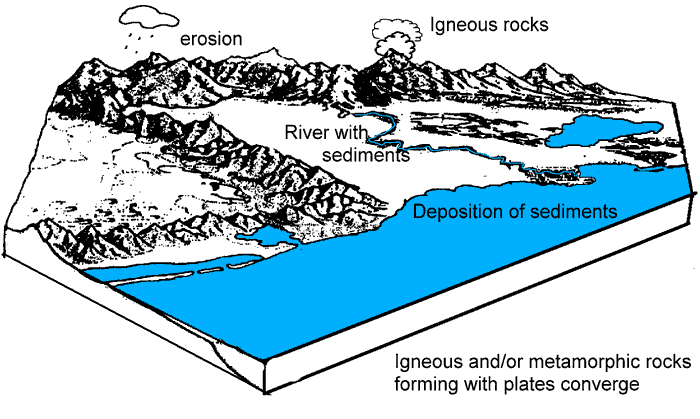BACKGROUND:
Sand has been used to describe many human qualities. A
vagabond is described as "driftless like ...sand" and " we
are all but a "grain of sand on the beach." Children look at sand
falling through an hour glass, fascinated by every grain that falls. Sand is
loved so much by children that adults have created sand boxes, so their
children can play.
Sand is the Earth in miniature. Every rock on the surface
of the Earth will erode and will become sediment or sand with time. This
process is part of the Rock Cycle. Mighty mountains are slowly chipped away
by natural forces like wind and rain. Sand is often associated with two very
opposite climatic conditions. Sand occurs at the beach, where waves
continually crash upon the shore, and in deserts, where wind sometimes
builds sand dunes. In both environments, some kind of erosion of the
surrounding rock is creating the sand.

Weathering produces sedimentary particles in a variety of
sizes and compositions. Erosion and transportation often reduce particle
size and destroy unstable minerals. As transportation ceases, the sediment
is deposited. Deposition takes place because the transporting medium no
longer has the energy needed to carry the particles. For example, a river
deposits sand as it flows into a lake. The smaller a particle, the longer it
takes to be deposited. This means that the largest and heaviest particles,
likely gravel-sized settle nearest to shore, while sand-sized particles are
deposited further out. Silt and mud grains, which are the smallest
particles, settle even further from shore.
When the particles are cemented together, each of these
grain sizes forms a corresponding sedimentary rock: Gravel forms
conglomerate, sand makes sandstone, silt makes siltstone, and clay forms
claystone. Rocks composed of clay- and silt-sized grains are often
collectively called shale. Note that these sedimentary rock names refer only
to grain size.
PROCEDURE:
- Ask students to bring small samples of sands from their homes (if
available). Your school's sand box, local beaches or garden supply
stores are also good sources of sands. Most commercial sand is derived
from a granitic source, so it should be light in color, and contain a
lot of quartz and feldspar crystals. Most commercial granitic sand is
also usually well sorted (this way no "dirt" sized particles
are present).
- Have the students compare their sands with the other students' sands
and with the sand in the lab and in the Sand Kit. Have them predict the
Mother Rock(s) for their samples. Remember that the ability to determine
the origin or Mother Rock from which the sand comes from is a much more
sophisticated and helpful process than knowing or being told the actual
Mother Rock.
- The worksheet can help you show your students how the particles from
erosion in a river form different layers. Heavy and large particles that
are moved by a river to an ocean or lake, drop out first to the bottom.
The smaller the particle the longer it takes to settle out of the water.
Sedimentary rocks form when particles (broken down rocks) are
"cemented" together by natural cements. In this diagram we
want the student to point out where gravel, sand, silt, and clay will
settle out. Gravel settles nearest to shore and the largest particles,
sand is larger than silt, and is deposited next, and silt is larger than
clay. Clay is deposited the furthest out.
- Ask students to predict where you would find siltstone, claystone,
sandstone and conglomerated. Siltstone would form when the silt sized
particles are cemented, claystone when the clay sized particles are
cemented, and sandstone when sand sized particles are cemented.
Conglomerate is cemented together gravel and any other larger or smaller
sized particles.
The Sedimentary Rock Classification Chart can help you compare
clastic and chemically derived sedimentary rocks.
|